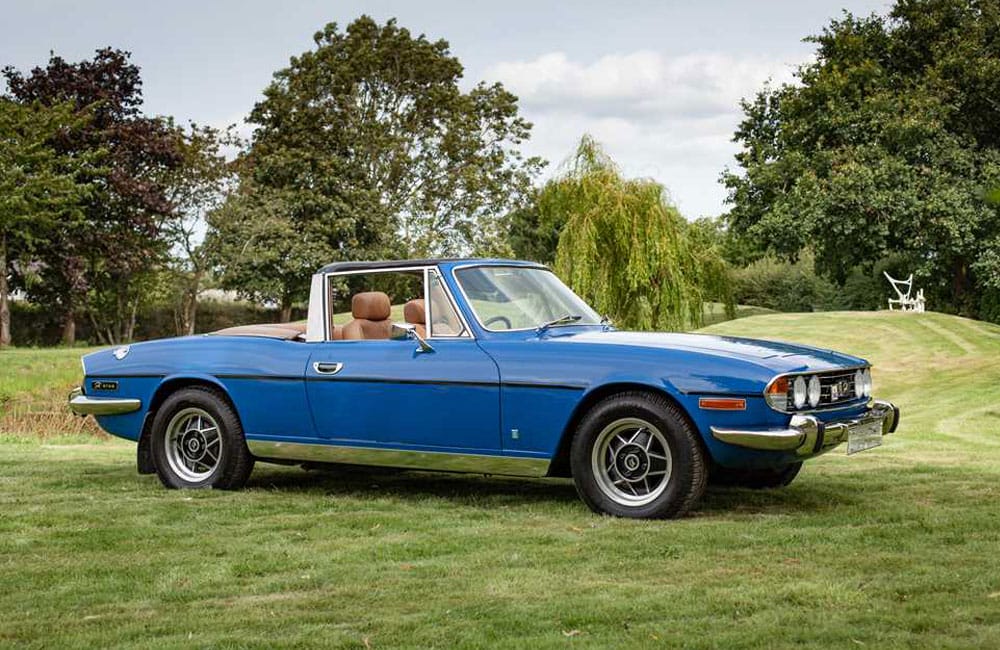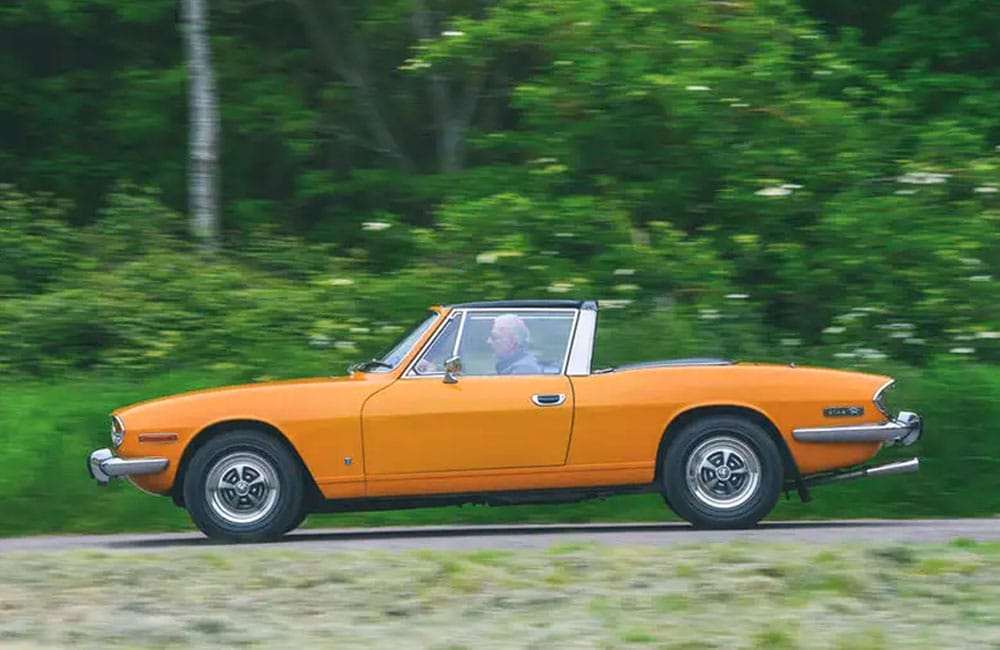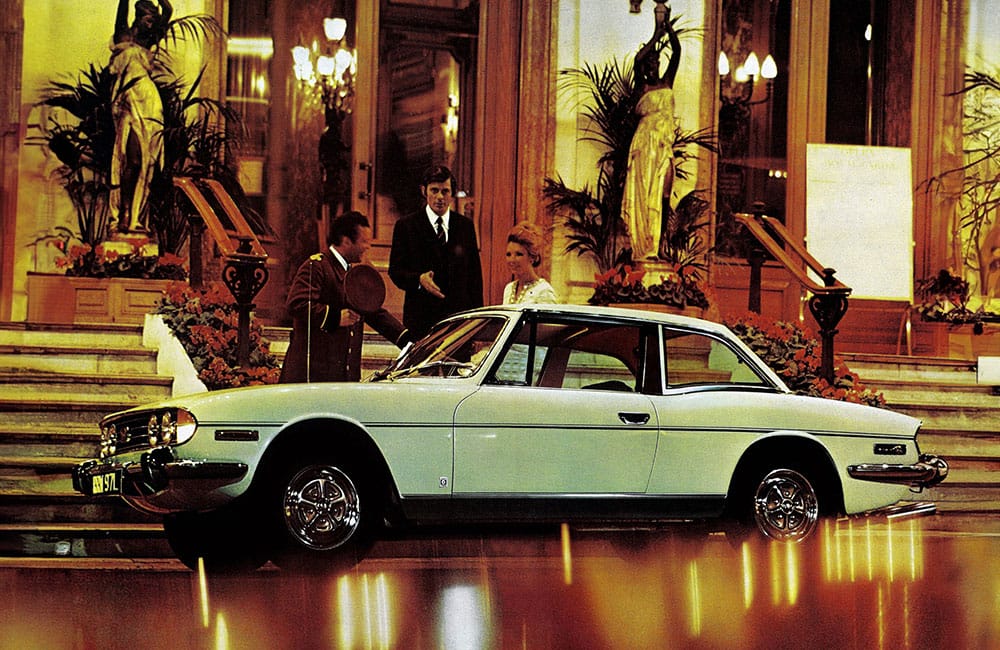
Ah, the beguiling Triumph Stag. Given the car’s history, it’d be so easy to write a headline for this piece something like ‘Snatching Defeat From The Jaws of Triumph’, or ‘Where Did it All Go Wrong?’ and, for a period back in the 1970s through to the early 80s, then very sadly that might have been somewhat appropriate. It’d be lazy writing, though, because it would ignore the remarkably positive side to the Stag’s story both during that period and since.
Now, in 2025, in the UK alone (let alone other countries) informed estimates are that around 8500 Stags survive – that’s half of all the UK market Stags built, an astonishingly high survival figure and a rock-solid testament to the popularity of the car in the world of classic cars.
A Grand Tourer That’s Aged Gracefully
The Triumph Stag was introduced in 1970 so, for those who came of age around that time and have admired it ever since, it comes as a rude reminder of the years that have slipped by to find that the Stag is 55 years old this year. Crikey.
There’s not many who’d deny that it’s a beautiful looking car and, from the start, it attracted the sort of celebrity ownership that did its image no harm at all: Roger Moore owned one, as did Sid James and ‘Jesus of Nazareth’ heart-throb actor Robert Powell. Journalist Jean Rook owned one, with her initials in gold leaf on the driver’s door, if you please, and it regularly featured in her column in the Daily Express.
Michelotti’s Vision Becomes Triumph’s Dream
Back in the beginning, in 1964, the Triumph 2000 saloon had been launched the previous year and Italian designer and stylist Giovanni Michelotti was looking to use it as a basis for a one-off motor show special. Triumph agreed to supply Michelotti with a Triumph 2000 to use as a basis, on the understanding that, if the resulting car was a really nice one, Triumph would have first refusal about taking it up as a new model and putting it into production.
When Triumph saw Michelotti’s creation, a convertible grand tourer based on the 2000 saloon’s floor pan in shortened form and featuring front and rear styling features that later would become very familiar on many Triumph products, the decision to take over the project and make it into a Triumph model was made straight away. Along with other Triumph projects of the 50s and 60s decades, the project was given a four-letter code name, in this particular instance, ‘Stag’. The Triumph Stag remains the only Triumph car where the project name was retained through into marketing and sales of the cars.


A New Engine with a Distinctive Voice
Project Stag then had to take its place in the congested Triumph new model development queue for a few years, during which the prototype’s 2000 straight six engine was replaced with a new 3.0 litre Triumph V8, one member of a new family of overhead cam engines being created for Triumph’s future. The most attractive feature of this new engine would be its glorious sound, a gorgeous V8 warble that instantly would become a signature feature of the car.
The Stag’s development also saw the introduction of a ‘T Bar’ roof structure to eradicate the unwanted scuttle shake experienced in the prototype car – perhaps slightly unwittingly, the nicely trimmed T bar added a second signature feature to the Stag, something that further set it apart from the contemporary open grand tourers, and still does.
A Promising Launch – and an Unexpected Problem
The car’s public launch took place in mid-1970, and the initial reaction was very favourable towards such a different, good looking approach to the open GT sector. By its size and features, the Stag didn’t strictly directly compare to any of the other cars that might be considered its competitors and, as such, had a bit of a niche to itself. The motoring press were a little less enthusiastic until they came to terms with the Stag’s unique position in the market. Far too many people, unfortunately, were a lot less enthusiastic once the weaknesses of the Stag’s new V8 engine had made themselves known.
Engine Troubles Tarnish a Brilliant Design
A grim rate of engine failures caused either by aspects of the engine’s cooling system (corrosion caused by the V8’s iron block/alloy heads and misunderstanding of the use of anti-freeze and corrosion inhibitor, casting sand still being present in, and blocking, coolant passages in the cylinder heads being two of the major fault causes), plus stretched and poorly tensioned timing chains leading to catastrophic failures, soon gave the engine a very unenviable reputation.
This was particularly the case in the United States, where the use of a V8 engine was hoped to win over many American customers, but ended up doing exactly the opposite. With its reputation pretty well destroyed in that market, the Stag was withdrawn from sale after only two years – a terrible blow for the car, after it had originally been envisaged that America would be the biggest market for it.


A Victim of British Leyland’s Struggles
The Stag never got anywhere close to its projected sales potential and production ceased in 1977. During the seven years of production, just under 26,000 Triumph Stags were built. Early sales projections had envisaged half of that total being sold every year.
The car was a victim several times over of the weaknesses of Triumph’s owning company, British Leyland. Due to BL board room pressure for sales, the car had been launched early before development and shakedown of the engine was complete. Then there was no money in the BL coffers to put things right, and the Stag only received a handful of relatively minor changes and upgrades during its production life. And, of course, there was the all-pervading BL malady of build quality back in the industrial strife torn 1970s, which was patchy at best but, far too often, a great deal worse.
The apparently obvious ‘fix’ for the engine, to fit the Rover V8 instead, couldn’t happen because every Rover V8 that could be built was needed more elsewhere. There were other issues around using the Rover V8, but production capacity was the primary one.
Lastly, crucially, the BL management were so busy fighting ‘more important’ fires within the organisation that neither the time nor the will were there to sort out a slow selling niche model that, even if all its problems were fixed, couldn’t significantly contribute to a turn around in British Leyland’s fortunes.
The Owners Who Saved the Stag
The public still really wanted to love the car and, amazingly, despite the awful troubles with the Triumph V8 engine, the Stag didn’t fade into obscurity after production finished. Through the late 1970s and early 1980s, quite a few Stags were resurrected by fitment of alternative engines, including Ford’s Essex V6, Triumph straight sixes, and of course, very predictably, the Rover V8.
The real turning point for the Stag was the formation of the Stag Owners’ Club, which was instigated by Stag specialist and enthusiast Tony Hart in 1978. Tony had already amassed, through his company Hart Racing Services, considerable experience of maintaining, diagnosing and repairing Stags, along with a passion for the cars, and he was at the forefront of ‘sorting out’ the Stag’s engine woes over the next few years, giving the car the attention that BL had neither the money nor, frankly, the inclination to do themselves.
Added to that, classic car enthusiast owners’ knowledge and understanding of correct treatment and maintenance of iron block, alloy head engines has become so much greater since the 1980s than it was for the poor old unwitting owners back in the 1970s, when such engines were very much the exception rather than the norm.

From Flawed Classic to Beloved Icon
Today, the Stag’s engine is no longer seen as a deterrent to buying and owning the car – you can experience and savour that gorgeous sounding engine note without fear or apprehension, while enjoying the particular uniqueness of the Stag’s grand tourer style and abilities at the same time. It’s fair to say the Triumph Stag is as popular and as loved, perhaps even more so, today as it was back in those excited, just post-launch days, in 1970.
Happy 55th birthday, Triumph Stag.
Pete Taylor, Editor.
Back To News

